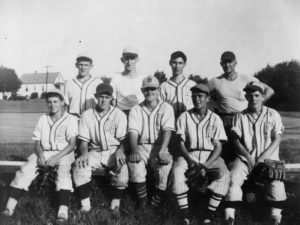
The Twilight League
See part two here.
See part three here.
With thanks to Harry Noyes III and the late Vin DiLauro
In 1959, The Boy lived on Kelsey Avenue; on summer nights, he was allowed to ride his bicycle up to Painter Park each night after dinner, “just as long as you’re home before dark.” This newfound freedom was exhilarating for the seven year-old, and unthinkable for any parent or child of today’s era.
Once he arrived at the park, The Boy would stop and watch part of the baseball games that seemed to be taking place every night. To The Boy’s inexperienced eyes, it was clear that this “Twilight League” was a far cry from Little League games that he had seen—these were men, not boys—and for sure they knew exactly what they were doing.
But where did the Twilight League come from and what are they doing today?
It is remarkable in our current age of social networking that somehow the West Haven Twilight League went from concept to reality in just a matter of days. On May 13, 1933, a group of sportsmen sat on a bench on West Haven Green; they were the Metcalfe brothers Herb, Bob and Ted, Johnny King, Ed Canavanm, Hugh O’Neil and Eddie “Shrimp” Flynn. A few days later, sports fans met at the West Haven Armory to elect the first slate of officers, and on May 18, 400 fans left West Haven’s old Town Hall and made their way to Painter Park, where they greeted the ball players. On that day, Flynn’s Collegians faced the North Ends in the league’s first game. As they played, someone passed the hat; nickels, dimes and even pennies were dropped in, and the League was off and running.
The Twilight League continued to enjoy the enthusiasm of the players and the community all the way into the 1940s, when they suspended play during World War II. When peacetime returned, so did the Twilight League, for the younger players and fans, as well as returning WWII veterans.
It should be noted that in 1959 the Painter Park ballfield on which they played was named Noyes Field in honor of the man who conceived it, saw it through, and spent his evenings picking stones from the field to make it more worthy of the games and the players who would play there: that man was Harry Noyes Sr.
Today, his grandson Harry Noyes III recalls fondly the evenings during the 1930s that grandfather and grandson spent, out there in a town truck, tending the ballfield.
To be continued-